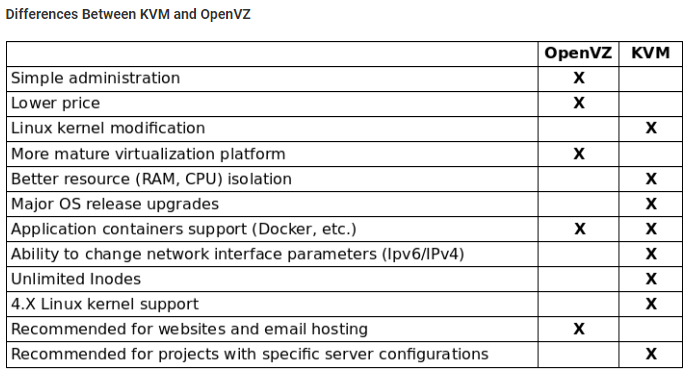
When choosing a Virtual Private Server (VPS), a common question is: "Which virtualization technology is better, KVM or OpenVZ?" Both have their unique characteristics, and understanding the differences can help you make an informed decision. Here’s a comparison of KVM and OpenVZ, two popular options available at VPS SELL.
OpenVZ
Overview:
OpenVZ is a container-based virtualization technology for Linux. It operates at the OS level, meaning that multiple containers share the same kernel but run isolated from each other. Each container behaves like an independent server with its own root access, users, IP addresses, memory, processes, files, applications, system libraries, and configuration files.
Pros:
- Efficiency: Since containers share the host’s kernel and other resources, OpenVZ is resource-efficient and has low overhead.
- Performance: Generally offers good performance with lower resource usage.
- Ease of Use: Often comes with pre-configured templates that can be easily installed with a few clicks.
Cons:
- Limited Kernel Modules: Only the kernel modules loaded by the host are available. If you need additional modules, you might not be able to enable them.
- Less Flexibility: Limited to the host’s kernel features, which might restrict certain applications or configurations.
KVM
Overview:
KVM (Kernel-based Virtual Machine) is a full virtualization solution. It allows running multiple virtual machines (VMs) with their own operating systems, which can be Linux, Windows, or others. Each VM has its own virtualized hardware, including a separate kernel, network card, disk, and graphics adapter.
Pros:
- Full Virtualization: Each VM operates independently with its own kernel and virtual hardware, providing a high degree of isolation and flexibility.
- Compatibility: Applications run in VMs as they would on a dedicated server, making it easy to migrate from a VM to a physical server.
- Kernel Customization: Each VM can run its own kernel, allowing for greater customization.
Cons:
- Resource Usage: KVM requires more resources compared to OpenVZ due to the overhead of virtualizing hardware for each VM.
- Performance Overhead: There may be a slight performance penalty regarding I/O and CPU usage due to the additional layer of virtualization.
Summary
KVM (Kernel-based Virtual Machine) is a full virtualization solution that allows multiple virtual machines (VMs) to run side by side on the same hardware, including both Linux and Windows operating systems. Each VM operates with its own private virtualized hardware—such as a dedicated kernel, network card, disk, and graphics adapter—enabling it to function independently.
Pros:
- Application Compatibility: Applications run within VMs just as they would on a dedicated server, ensuring high compatibility.
- Kernel Customization: Each VM can use its own kernel, offering flexibility in configuration and software support.
- Migration Flexibility: VMs can be easily migrated to physical servers or other virtual environments.
Cons:
- Resource Usage: KVM requires more resources compared to OpenVZ due to the overhead of virtualizing hardware for each VM.
- Performance Overhead: The additional virtualization layer can lead to slight performance penalties in terms of I/O and CPU efficiency.
